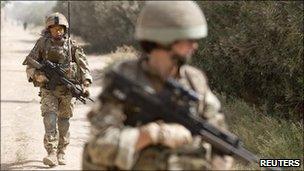MoD announces details of 4,200 job cuts
- Published

The Army needs to reduce its total fighting force to 82,000 by 2020
The Ministry of Defence has announced 4,200 job cuts in a second round of armed forces redundancies.
The Army will see up to 2,900 job cuts, including 400 Gurkhas, while the RAF will lose up to 1,000 members and the Royal Navy up to 300.
The job losses will account for some of the cuts announced under the defence review - intended to help plug a £38bn hole in the defence budget.
Ministers said there was "no choice" but to axe the posts.
Under the terms of the Strategic Defence and Security Review, external, announced in 2010, the navy and the RAF have to cut 5,000 jobs each by 2015, the Army 7,000 and the Ministry of Defence 25,000 civilian staff.
Last September 2,860 people were selected for the first tranche of redundancies, with the Army and RAF each losing 920 posts, and 1,020 cut from the navy.
Defence Secretary Philip Hammond said the government had "no choice but to reduce the size of the armed forces - while reconfiguring them to ensure they remain agile, adaptable and effective".
Mr Hammond said: "As we continue with the redundancy process we will ensure we retain the capabilities that our armed forces will require to meet the challenges of the future."
Shadow defence secretary Jim Murphy said mass redundancies would be of "deep concern" across the country.
Mr Murphy said Labour agreed there was a need for cuts to the defence budget but warned the plans announced were "wrong-headed and rushed".
He said: "Savings must be made and Britain will need to confront global threats with leaner, more advanced armed forces in future.
"The most important baseline, however, is national security and we worry these cuts are wrong-headed and rushed. We need to know the full military impact of losing such important capability."
Senior ranks
In 2011 further reductions were identified for the regular Army, as the government sought to put greater emphasis on military reserves. Its total fighting force needs to drop from around 100,000 to 82,000 by 2020.
The current round of redundancies affects private soldiers through to the senior ranks - with some eight brigadiers and 60 lieutenant colonels being made redundant.
The navy will lose about five commodores, 17 captains and 19 Royal Marine officers. In the RAF, up to 15 air commodores and 30 group captains will be among the posts to be cut.
Military planners had already singled out the 3,500-strong Gurkha Brigade for job cuts, arguing they were overmanned.
The loss of about 400 Gurkha personnel announced on Tuesday follows an estimated 140 cuts to the brigade during the first wave of MoD cuts last year.
Major Tikendra Dal Dewan, chairman of the British Gurkha Welfare Society, said the news was saddening.
He said: "What we don't understand is why we have lost around 140 men in the first tranche and now we are losing another 400 when we have just 3,500 but the infantry, which has tens of thousands [of personnel], are only losing 500 across the board."
The Gurkhas, based at Shorncliffe in Kent, have been part of the British Army for more than half a century.
Following the partition of India in 1947, an agreement between Nepal, India and Britain meant four Gurkha regiments from the Indian Army were transferred to the British Army, eventually becoming the Gurkha Brigade.
The Royal Air Force is not seeking to make trainee pilots redundant, or to cut pilots at ranks below group captain level.
Both the Royal Navy and the RAF expect this to be their last round of redundancies, with natural wastage and a recruitment freeze in some areas making up for the rest.
- Published13 January 2012
- Published18 July 2011
- Published19 October 2010
- Published27 July 2010
- Published31 July 2011
- Published4 April 2011
- Published19 October 2010